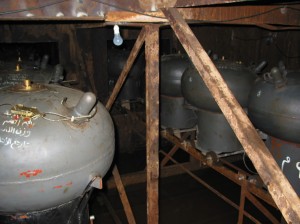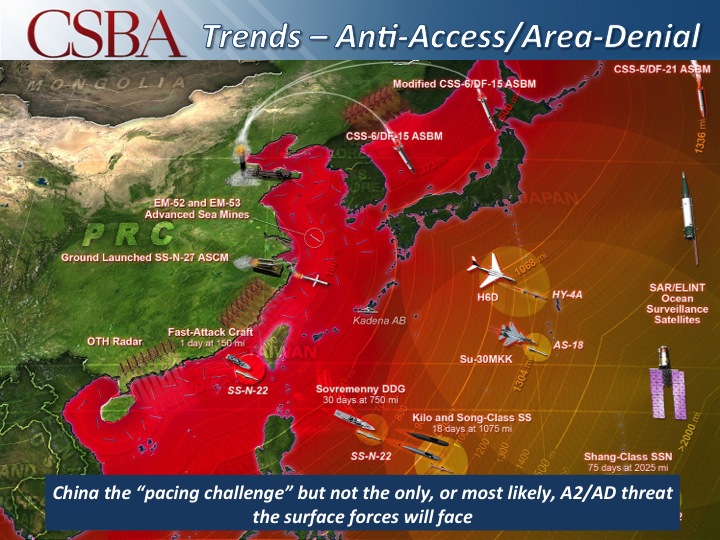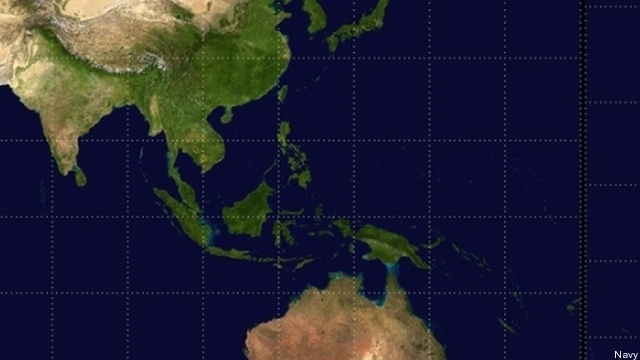Sowing The Sea With Fire: The Threat Of Sea Mines
Posted on

US and foreign minesweepers at the IMCMEX 2013 wargames.
This is the second in our exclusive series on the crucial but neglected question of sea mines and how well — or not — the United States manages this very real global threat. Only 4.7 percent of the US Navy’s 275 warships are dedicated to mine warfare. Those small numbers face Iran’s several thousand naval mines, North Korea’s 50,000, China 100,000 or so, and Russia’s estimated quarter-million. If you just count the numbers, the US seems to be at a staggering disadvantage. But there’s some good news. Read on. The Editor.
The Navy can field only 13 Avenger-class minesweepers – a fourteenth, the USS Guardian, was wrecked in 2013 – and 31 MH-53E helicopters to cope with the more than 400,000 sea mines in the hands of US competitors and enemies. But war is never just about the numbers. Nor is it about simply opposing each kind of attack with a specific defensive countermeasure. The best defense against sea mines is a good offense. Instead of trying to find and destroy the mines after they’re already in the water, you find and destroy the enemy’s minelayers before they can get anything in the water in the first place – something that the US Navy and, just as important, the Air Force have plenty of ways to do.
In March 2003, for example, on the eve of the invasion of Iraq, Australian forces intercepted four converted civilian vessels carrying 86 mines, including 20 of the advanced Italian-made Manta type. A single Manta had nearly sunk the USS Princeton during the First Gulf War a generation before, when the Iraqis had laid 1,500 mines off the Kuwaiti coast. “We didn’t catch any of the ships before Desert Storm,” said Bob O’Donnell, a retired Navy captain and veteran minesweeper.

Iraqi mines captured in 2003, before they got in the water.
Sowing the sea with thousands of mines is a massive logistical effort, one with multiple steps that the US can detect and disrupt. To start with, an adversary must get its mines out of storage and arm them. Typically, “countries will have their mines in ammo dumps somewhere, [but] without any sensors in them,” said O’Donnell. “The first step is they take them out of the dumps and take them someplace where they put the sensors in.” The more mines they move, the more people and trucks they need, which makes it more likely someone will let something slip or that US spy satellites will notice suspicious activity.
Then the bad guys need to get the mines in the water. Typically that is done by a surface vessel, but some specialized mines can be dropped from an aircraft or even launched into position by a submarine. Planes are much faster and subs are much stealthier, but for sheer volume, you need to go with ships.
So how many ships? Consider China, the worst-case adversary. “They’ve got a lot of weapons, but the means of delivery are relatively few,” said mine warfare expert Scott Truver. By Truver’s estimate, the People’s Liberation Army Navy (PLAN) has 80,000 to 100,000 sea mines. The good news: it’s got only one purpose-built minelayer, which can carry 300 mines at a time.
However, other PLAN ships can help. According to a study by three Navy War College professors, the PLAN has at least 43 warships built primarily for other missions – frigates, destroyers, and amphibious landing ships – that can also carry 30 to 60 mines each. It has “hundreds” of smaller vessels – gunboats, torpedo boats, patrol craft, and (ironically) minesweepers – that can carry at most a dozen mines apiece, although their range prevents them from going too far out into the open ocean. Still, if China actually used all these surface vessels at once, at the price of other missions, they could dump thousands of mines in the water before they ran out and had to go back to port for more.
If Beijing really wanted to go for broke, though, it could mobilize its largely state-controlled fishing fleet: 30,000 trawlers able to carry 10 mines each and, for defensive mine-laying just off China’s own coast, some 50,000 sailboats that could carry two to five mines.
Turning all those vessels into minelayers isn’t easy, however. Civilian craft are certainly the best way to lay mines covertly in small numbers, but a large-scale effort would involve so many civilians that it would be impossible to keep quiet. Just the process of loading mines aboard hundreds of ships, let alone thousands, would be difficult for spy satellites to miss.
Once the US and its allies spotted the beginnings of such a massive minelaying effort, they would have to decide what to do about it. It is in fact entirely legal under international law to lay mines in international waters, as long as you make public what areas you’ve mined so civilian shipping can stay away. Strategically, though, it is unlikely that Japan would sit still if China tried to mine the waters around the disputed (although uninhabited) Senkaku Islands (called the Diaoyus in Chinese), or that the Philippines would tolerate China mining the disputed (and potentially oil-rich) Scarborough Shoal, or that Taiwan would shrug off China mining their shipping lanes in an effort to blockade the island nation.
It’s likely there would be some kind of standoff at sea, like the one in 1962 when the US Navy intercepted Soviet ships carrying nuclear missiles to Cuba. If Beijing decided to bull ahead, or if anyone on either side got an overly itchy trigger finger, the result might be a full-scale “Air-Sea Battle” in the Western Pacific, with US aircraft sinking Chinese’s trawlers-turned-minelayers en masse. Whoever prevailed in the end, the original minelaying effort would be interrupted by the larger crisis.

Sneaky Subs, Fast Planes
Could China lay mines before anyone could react? Possibly, but it would have to eschew a massive armada of surface vessels in favor of aircraft, which are much faster, or submarines, which are much more difficult to detect.
China has been careful, in fact, to equip its entire submarine fleet to lay mines. It has about 70 subs able to carry 20 to 30 mines apiece, according to the Navy War College experts — Andrew Erickson, Lyle Goldstein, and William Murray. Between 50 and 60 of those boats are short-range diesels, most of them obsolete and loud. But, at least five Chinese boats are modern, nuclear-powered craft capable of traveling long distances. They would be hard to find.
Certainly the Chinese have learned from history, both from German U-boats closing US harbors in 1942 and from America’s own war against Japan:
“According to statistics from the US Navy mine campaign in Japanese waters, using surface vessels to sow mines, roughly 257 mines were required per vessel sunk or damaged; relying on aircraft to sow mines yielded an average of 27 mines per vessels sunk or damaged; but employing submarines to lay mines achieved an average of just 12 mines per vessel sunk or damaged,” enthused Chinese author Ren Daonan in 1998. “It is easily apparent that combat efficiency of submarine-laid sea mines exceeds that of most other military forces and systems.”
So could the Chinese shut down key West Coast harbors, especially the Pacific Fleet’s main base in San Diego? It “would be really, really, really difficult to carry off,” said Truver.
Chinese nuclear submarines could certainly reach Guam, America’s main naval base in the South Pacific. The sub would not even have to enter the harbor: China has a significant arsenal of what it calls “self-navigating mines” that are launched like a torpedo but, instead of detonating immediately, deposit themselves at a pre-selected location and wait.
Space is at a premium inside a submarine, however, and once a sub has used up its cargo of 20 to 30 mines, it has a long journey back to base to get any more. That makes subs the underwater equivalent of a sniper rifle, not a machinegun: Instead of rendering large areas too dangerous to pass through, they would sneak a small number of sophisticated mines into some crucial chokepoint, such as a harbor entrance.
The best way to lay mines en masse before anyone can react is to drop them from aircraft. It’s a technique the United States itself used against Imperial Japan almost 70 years ago. Ericson and company estimate that China’s hundred or so H-6 bombers, “though obsolete for many missions,” could carry as many as 18 large mines apiece and indeed have been used for minelaying exercises already. Another hundred JH-7 fighter-bombers could carry 20 smaller mines apiece.
So a single massive sortie of all 200 available aircraft could – in theory – put almost 4,000 mines in the water in a matter of hours. And they could drop those 4,000 as far out as the so-called “First Island Chain,” which runs from Japan to Taiwan to the Philippines. That’s only a tiny fraction of China’s inventory, but enough to have a strategic effect if concentrated in a limited, strategically vital area. For comparison, the Iraqis laid roughly 1,500 mines off the coast of Kuwait before the First Gulf War, enough to keep 17,000 Marines from attempting an amphibious landing (though they stayed at sea as a diversion).
The problem with aircraft is that everyone with a radar could see the planes coming, literally, miles away. Few countries would just watch 200 inbound warplanes without scrambling their own fighters, at least to take a look. The first wave of aircraft might get to drop its mines and head for home before the US and its allies had figured out what to do, leaving a lethal fait accompli in the water, in a limited area. A second sortie, however, would trigger the same kind of crisis as a massive deployment of minelaying ships – except a face-off between jet aircraft would have move much faster with much less margin for error.
So would one wave be enough? That depends on where the mines went. It’s all math.

The Distance Factor
Narrow waterways are a minelayer’s dream. The Strait of Hormuz, the only exit from the Persian Gulf, narrows to just 21 miles across. By contrast, the vastness of the Pacific is a minelayers’ nightmare. Even the gap between South Korea and Japan, for example – called the Korea Strait by Seoul and the Tsushima Strait by Tokyo – has two channels, each more than 21 miles across. And that’s one of the Western Pacific’s narrowest chokepoints.
Japan’s home islands and Taiwan are 700 miles apart, linked by the loose chain of the Ryukyu Islands. Taiwan has almost a thousand miles of coastline, half of it on the side away from China, so a mine “blockade” would have to be a belt at least 500 miles long. (Putting a minefield right in front of every Taiwanese harbor would be more efficient but much easier for Taiwanese forces to stop). From Taiwan to the Philippines is “just” 275 miles, but the Philippines themselves, like the Indonesia archipelago beyond them, consists of many islands, large and small, with many channels in between, offering many potential detours around a minefield.
The famous Strait of Malacca, through which most of East Asia’s oil flows, is only 1.7 miles across. But if it were mined, the Chinese would cut their own most direct supply of Persian Gulf oil. In any case, tankers could detour around Sumatra, Java, and Timor, then head north. It would cost considerable time and money to take the long route, but it would hardly cripple seaborne commerce.
Mines are the maritime equivalent of roadside bombs, but there are no roads at sea. Since 70 percent of the planet is covered by water, there’s almost always a way around. Navy doctrine emphasizes finding minefields, but not necessarily destroying them. In many cases, said Captain Aaron Peters, a Navy mine-warfare expert, “if you can mine-hunt and identify where they are, you can avoid those areas.”
There are a few places, however, where you can’t go around. Unfortunately, one of them is the only way tankers can get out of the Persian Gulf. The U.S. Energy Information Agency calculates that almost 20 percent of all oil traded worldwide – all oil, counting both tankers and pipelines – moves through the Strait of Hormuz. So does 20 percent of the world’s liquefied natural gas, almost all of it from Qatar. Because relying on tankers is so much cheaper and easier than building pipelines, notes the EIA report, “most potential options to bypass Hormuz are currently not operational.”
Geostrategically, it’s worth noting that China is now the world’s largest net importer of oil, so its interests in the Gulf align with the United States and its allies on one key point: The oil must flow.
At its narrowest point, the Strait of Hormuz is just 21 miles wide. (Ships are required to pass through a six-mile-wide set of shipping lanes, but that’s a limitation of traffic control, not of geography). During the “tanker wars” of the 1980s, the super-tankers formed convoys with US escorts and pushed on through in single file, trusting in their sheer huge bulk to keep them afloat if they hit something – which is exactly what happened to the tankers Bridgeton and the Texaco Caribbean in 1987. However, that time Iran did not make an all-out effort to seal off the Gulf.
In contrast to the vast distances of the Pacific, the Strait of Hormuz is right off Iran’s shore, an easy target for a sudden surge of small craft. If Iran could lay 2,000 mines in a mile-wide belt across the Strait, that’s almost 100 mines per square mile. (Iran probably has several thousand mines all told, though some estimates put its inventory as high as 20,000). With a mine, on average, about every 550 feet, no tanker captain would trust to luck and bulk to see him through.
So someone would have to clear a path. Getting mines out of the water once they’re already in it is dangerous and difficult – especially if you have to do it under fire from Iranian fast-attack boats and shore-based missiles with the range to shoot right across the Gulf. That battle is the subject of the next article in our series.
Edited 10:40 am to use most recent fleet size figures.
Subscribe to our newsletter
Promotions, new products and sales. Directly to your inbox.
